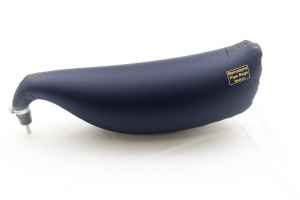
Bannatyne Uncut Pipe Bag for Small Pipes (IN STOCK)
Quantity in Basket:
NonePrice:
$75.00Shipping Weight:
2.00 poundsUncut Plain Bannatyne Pipe Bag - Medium size only (10.5" X 26.5"). This Bannantyne bag is intended for use with smallpipes. There are no holes or collars, so the bag must be cut and tied on like a traditional pipe bag.
What type of pipe bag should I play? The three basic bag types are Leather,
Synthetic and Hybrid, and each type can either be the "sealed" or "zippered"
style. Zippered bags are more expensive than sealed, but allow easy access for
finding missing drone reeds, and adding accessories like tone enhancers ,
valves and warer traps .
Leather Bags must be
treated (seasoned) to seal the inside pores in order to make the bag airtight.
Once you have done this you have also created a potential water problem as the
moisture from your breath can no longer escape from the bag and will condensate
on the drone and chanter reeds thus creating a very unsteady sounding bagpipe.
Synthetic Bags are usually made of Gortex, a low maintenance, man-made
material that is airtight, yet allows moisture to wick out of the bag overnight
so that you are always starting each session with a dry bag. You will see in
coming issues that a dry system is what you want for ideal playing conditions.
Hybrid Bags are leather on the outside with a synthetic lining on
the inside. These are more expensive, but offer the traditional look and feel of
the leather bag with the modern advantages of synthetic. The thicker walled bag
also provides better resonance for sound quality.
How do I check for
Air Tightness? The first step in good bagpipe maintenance, and this should
be done at the change of every season, or 4 times a year. Never put a pipe bag
in water to check for air leaks, because as soon as you do, you can kiss the
manufacturer's warranty good-bye. Remove the pipe chanter and the drones from
the stocks, insert large rubber stoppers into the stocks and fully inflate the
bag. Then place your thumb over the open end of the mouthpiece to prevent any
air loss, put the bag under your arm and squeeze with as much pressure as you
can for 30 seconds, then blow back into the bag. If the bag takes more than the
smallest amount of air, you need to check that all the stocks are tied in
tightly, that stocks are free from cracks, and if you are playing a leather bag
it may need seasoning. If your bag still leaks air it's time to replace it.
What Size Pipe Bag Should I Play?: Yes, here size does matter.
Probably the most common mistake pipers make is trying to play a bag that is too
large for them. The two main things that can determine the size bag you need are
arm length and chest size.
A quick guide to bag size selection -
Small or Extended Small if you are under 5'-7" tall, Medium for 5'-8" to 6'-1",
Large if you are over 6'-2". A larger person can play a smaller bag without
harming the shoulder, arm, neck or wrist, but a smaller person playing a bag
that is too large is asking for shoulder, arm, neck and wrist problems.